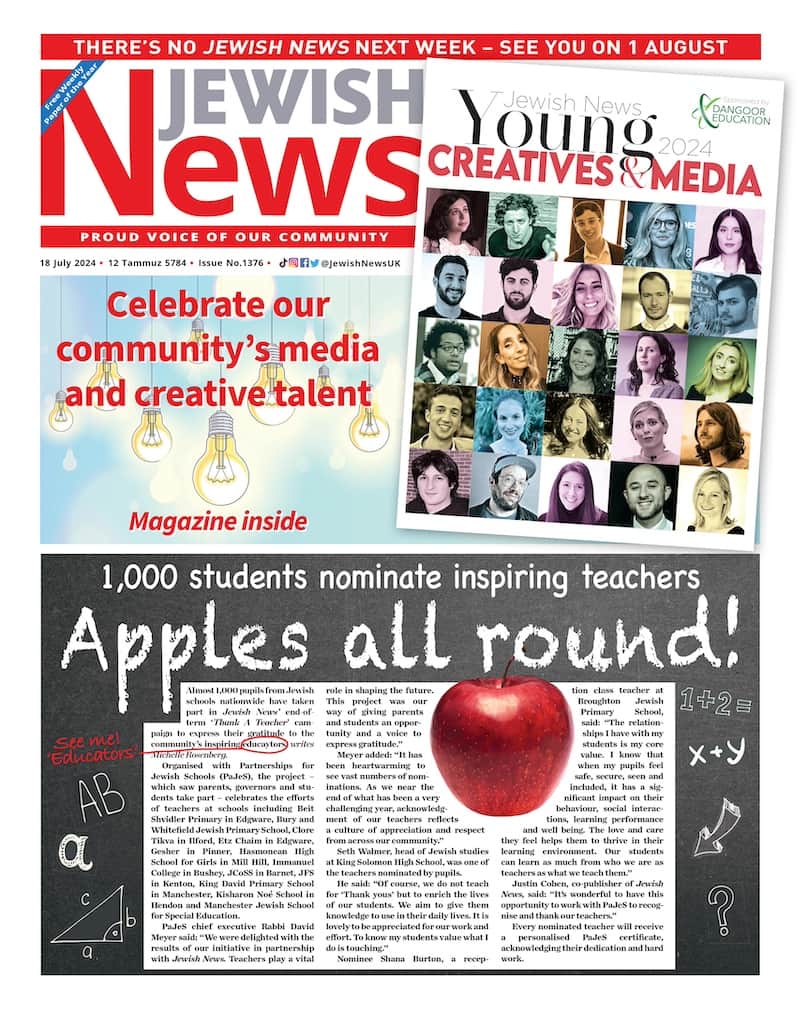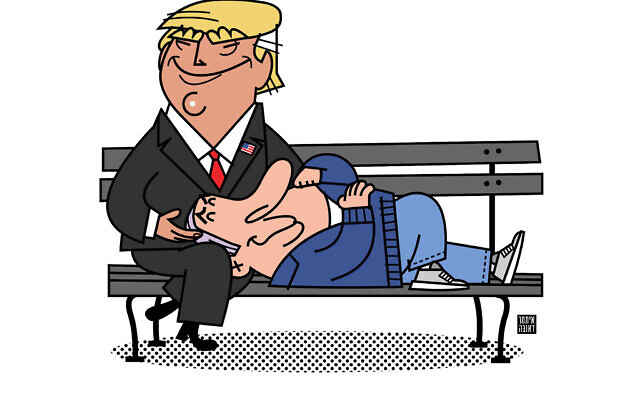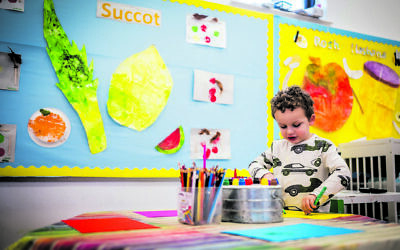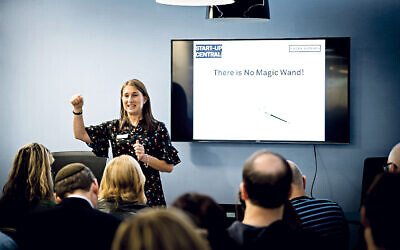Bigger picture: A history of Israel in 100 cartoons
Drawing parallels between Jews and cartoonists, Dr. Colin Shindler speaks to Jewish News' Jenni Frazer about Golda Meir, Soviet Jewry and Natan Sharansky
Jenni Frazer is a freelance journalist
Cartoonists are the gadflies of society, often summing up in one pithy drawing and caption, an image which can make the viewer laugh aloud — or gasp in shock. They touch nerves, saying the un-sayable.
So it seemed more than fitting when the academic and historian Dr Colin Shindler decided to marry his twin loves — cartoons and Israel — in a new book, ‘A History of Israel in 100 cartoons’.
It’s something which has never been done before, but, as with all the best ideas, it leaves the reader wondering why not.
“Cartoonists are outsiders,” says Shindler. “They challenge the accepted wisdom. I think cartoons are amazing, they bring a smile to the face and they can often tell a story in an instant. I admire the brilliance of cartoonists. And it occurred to me that cartoonists have been persecuted by authoritarian leaders who don’t like what they see; and that a disproportionate number of Jews have been involved in satire. So I thought, yes, Jews and cartoonists have a direct connection”.
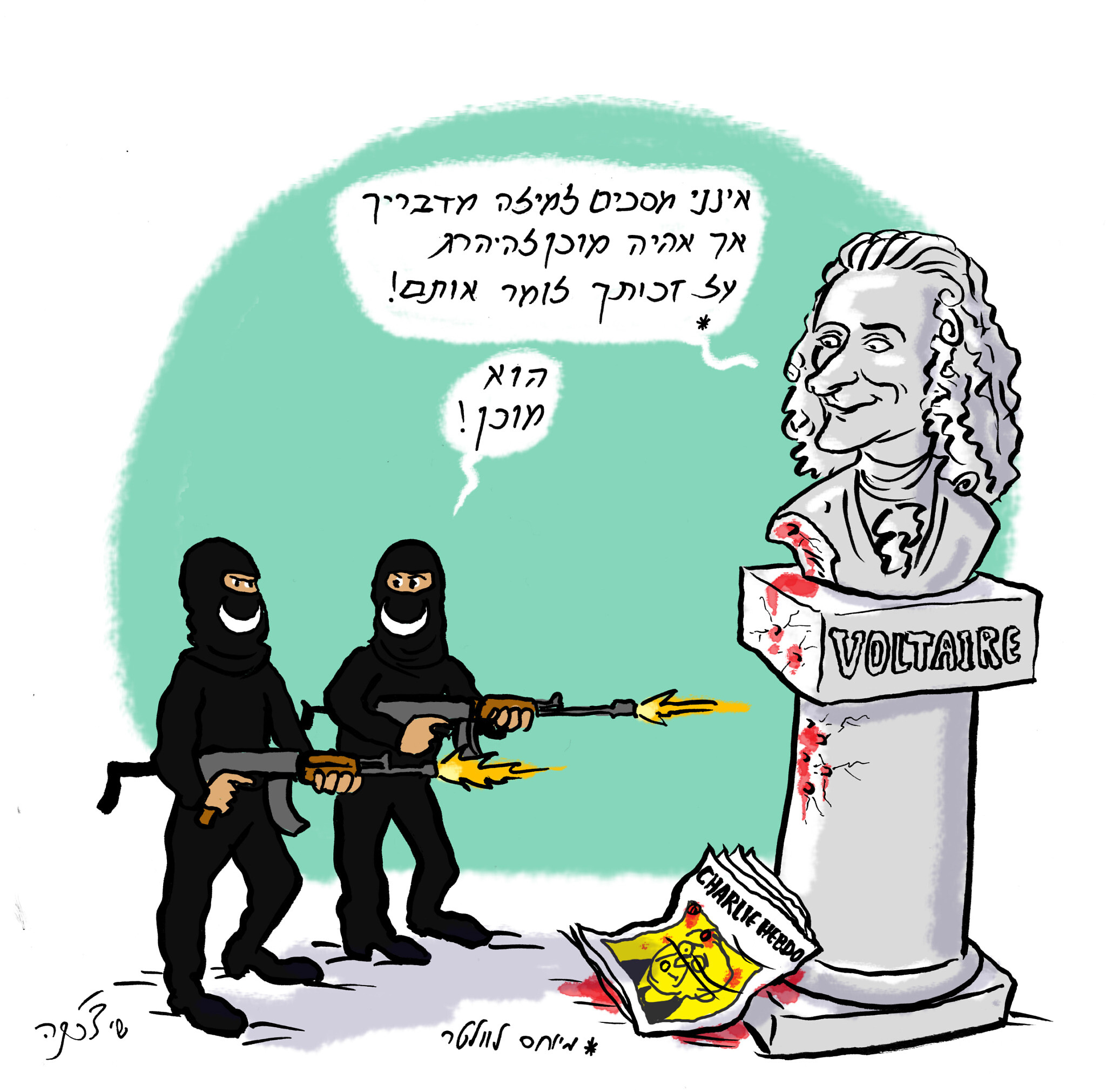
The killing of the Charlie Hebdo cartoonists and the attack on the Hypercacher kosher supermarket in Paris by Islamists demonstrated an inability to accept difference — whether offensive cartoons in a satirical periodical or Jews who were out shopping. The four killed in the supermarket, François-Michel Saada, Philippe Braham, Yohan Cohen and Yoav Hattab were buried in Jerusalem. Here Voltaire is stating his often quoted comment that ‘I do not agree with what you have said, but I am prepared to defend to the death your right to say it’. The armed assailants, standing in front of a blood-stained bust of Voltaire and a copy of Charlie Hebdo, are amazed at Voltaire’s comment about the right to a different opinion and one comments sarcastically: ‘He is prepared!’ Shay Charka (Makor Rishon 9 January 2015) Credit: Professor Colin Shindler.
He began his research in 2015 for the publisher, Cambridge University Press, and freely admits that it is “the hardest book I have ever written.” He spent many hours in Tel Aviv’s Cartoon Museum, and if he drew a blank when finding the ideal image there, would work in the National Library of Israel.
Cambridge imposed a limit of 100 cartoons — echoing the success of the former director of the British Museum’s Neil MacGregor with his book, ‘A History of the World in 100 Objects’. Shindler’s book is not quite so ambitious but it is daunting nevertheless, as he traces Israel’s tumultuous journey over the last 75 years.
What to include, what to leave out?
Each year gets a chronological listing of the big events — introduced by a knowledgeable essay discussing them. But then there is the unenviable task of picking a definitive image of that year.
Israel produced a number of cartoonists in its early years as a state, several from Hungary. Shindler was able to track down the families of those cartoonists who were no longer alive, such as probably the best-known, Dosh and Ze’ev. “The families were absolutely delighted that recognition was once again being given to their fathers or grandfathers”.
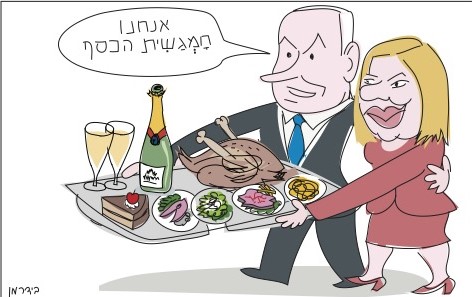
The mounting criticism of Netanyahu as a shady practitioner of the black arts of Israeli politics was compounded by his extravagant lifestyle — particularly in the realm of haute cuisine and gourmet restaurants. The behaviour of his wife, Sara, in this context became a recurring feature of public criticism. Amos Biderman (Ha’aretz 25 June 2018). Credit: Professor Colin Shindler.
Shindler’s near-encyclopaedic knowledge of Israel’s history allows him to unpick even the most obscure of references in the cartoons, particularly in the early years of the state, when big and controversial issues have faded from our consciousness. Every cartoon is carefully explained, and even if we recognise some of the big political beasts, Shindler is on hand to tell us that this figure is Levi Eshkol, Israel’s third prime minister, or that the pipe-smoker in the background is soldier, politician and archaeologist Yigal Yadin.
It’s easier with figures such as Golda Meir, the eyepatch-wearing Moshe Dayan, or the wonderfully bushy-haired David Ben-Gurion, surely a cartoonist’s dream. All three of them appear in a Dosh cartoon in Ma’ariv in April 1971, showing Golda taking over the Labour Party, but nobody having any idea where they are going. On the margin stand two perplexed figures — Jordan’s King Hussein and Egypt’s Anwar Sadat.
Closer to our own time — the book concludes in 2020 — there are some deliciously stinging cartoons: Netanyahu wearing a series of different hats as he tries to become all things to all men; a 2010 one that doesn’t take much artistry, but is hard-hitting nevertheless, showing Israel on “Gilad Shavit” time, marking the long years of the soldier’s capture; and, in probably the most striking image in the entire book, a beautifully detailed drawing of former premier Ehud Olmert, a cigar and a “brown envelope” in his pocket — and a fraying noose around his neck. It was drawn in 2008 as the snappy dresser fought — ultimately unsuccessfully — corruption charges.
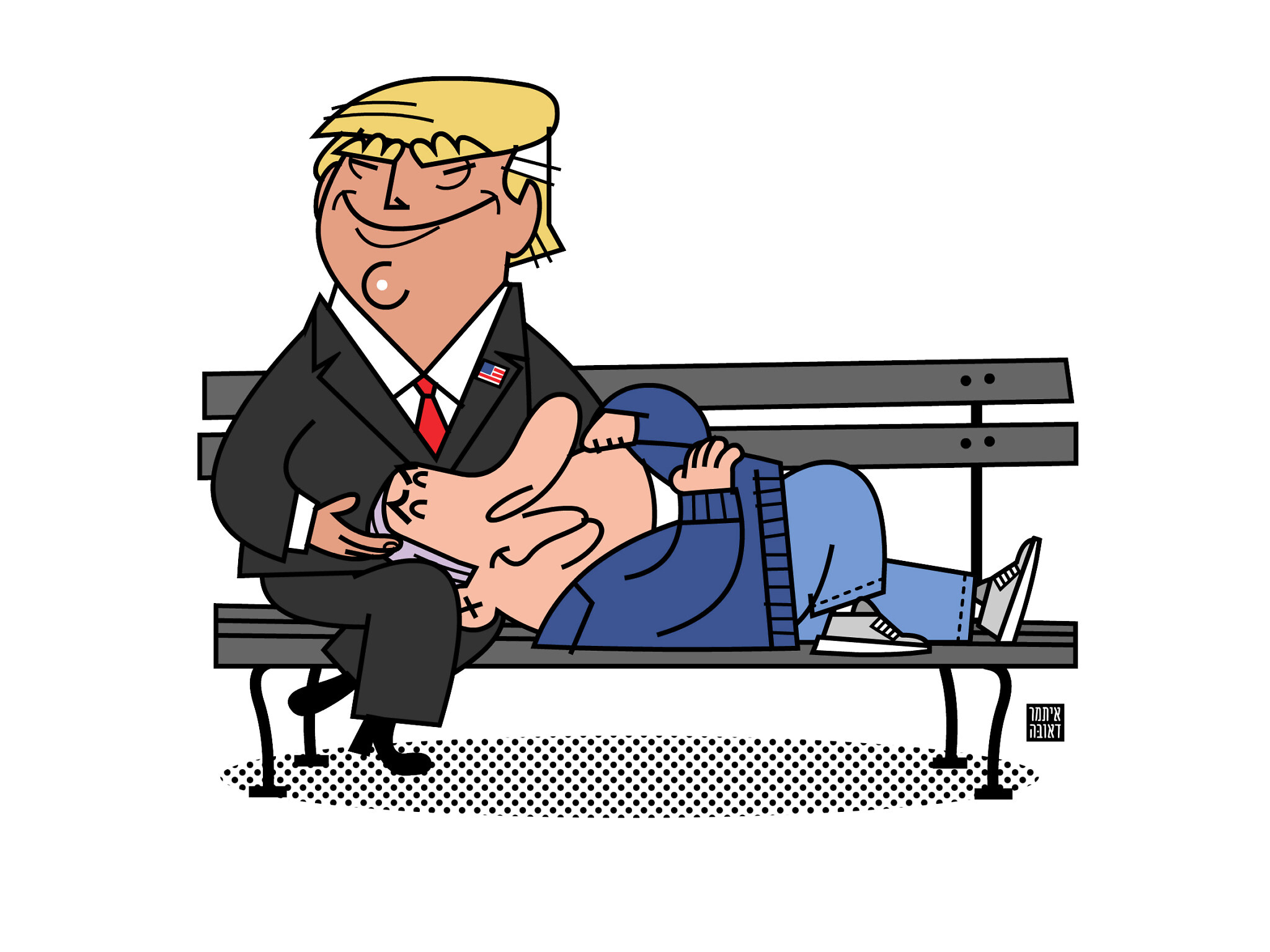
This imagery is based on a photograph of Netanyahu, resting his head on the lap of his wife, Sara. It implies Netanyahu’s contentment with the new occupant of the White House. Itamar Daube (Yediot Aharanot 12 November 2016) Credit: Professor Colin Shindler.
Or there is a 2016 cartoon of Netanyahu and Trump, when their “bromance” was at its height. The picture is based on a photo well-known at the time of Netanyahu lying with his head on the lap of his wife Sara. This time, Itamar Daube has drawn the prime minister contentedly napping on Trump, who had just been elected US president.
One of the motivations for writing the book, Shindler says, “is to pay a debt of honour”. He has dedicated the book to two members of the 35s, the extraordinarily successful Women’s Campaign for Soviet Jewry. Zelda Harris, now in her 90s, lives today in Tel Aviv, while Sylvia Becker, who made aliyah in 1980, died aged 93 in 2019. Both women were at the forefront of the Soviet Jewry campaign throughout the 1970s. Shindler, himself an architect of the Soviet Jewry campaign in the UK, does not want their tireless work to be forgotten.
And Soviet Jewry is gently reflected in an image showing the eventual release of Natan Sharansky from solitary confinement in the USSR. In the same image as the celebratory white dove, there is a black dove — carrying the label of Nelson Mandela.
Colin Shindler will be discussing Israel: A History in 100 Cartoons on February 26 at Jewish Book Week. The book is published by Cambridge University Press.

Thank you for helping to make Jewish News the leading source of news and opinion for the UK Jewish community. Today we're asking for your invaluable help to continue putting our community first in everything we do.
For as little as £5 a month you can help sustain the vital work we do in celebrating and standing up for Jewish life in Britain.
Jewish News holds our community together and keeps us connected. Like a synagogue, it’s where people turn to feel part of something bigger. It also proudly shows the rest of Britain the vibrancy and rich culture of modern Jewish life.
You can make a quick and easy one-off or monthly contribution of £5, £10, £20 or any other sum you’re comfortable with.
100% of your donation will help us continue celebrating our community, in all its dynamic diversity...
Engaging
Being a community platform means so much more than producing a newspaper and website. One of our proudest roles is media partnering with our invaluable charities to amplify the outstanding work they do to help us all.
Celebrating
There’s no shortage of oys in the world but Jewish News takes every opportunity to celebrate the joys too, through projects like Night of Heroes, 40 Under 40 and other compelling countdowns that make the community kvell with pride.
Pioneering
In the first collaboration between media outlets from different faiths, Jewish News worked with British Muslim TV and Church Times to produce a list of young activists leading the way on interfaith understanding.
Campaigning
Royal Mail issued a stamp honouring Holocaust hero Sir Nicholas Winton after a Jewish News campaign attracted more than 100,000 backers. Jewish Newsalso produces special editions of the paper highlighting pressing issues including mental health and Holocaust remembrance.
Easy access
In an age when news is readily accessible, Jewish News provides high-quality content free online and offline, removing any financial barriers to connecting people.
Voice of our community to wider society
The Jewish News team regularly appears on TV, radio and on the pages of the national press to comment on stories about the Jewish community. Easy access to the paper on the streets of London also means Jewish News provides an invaluable window into the community for the country at large.
We hope you agree all this is worth preserving.

